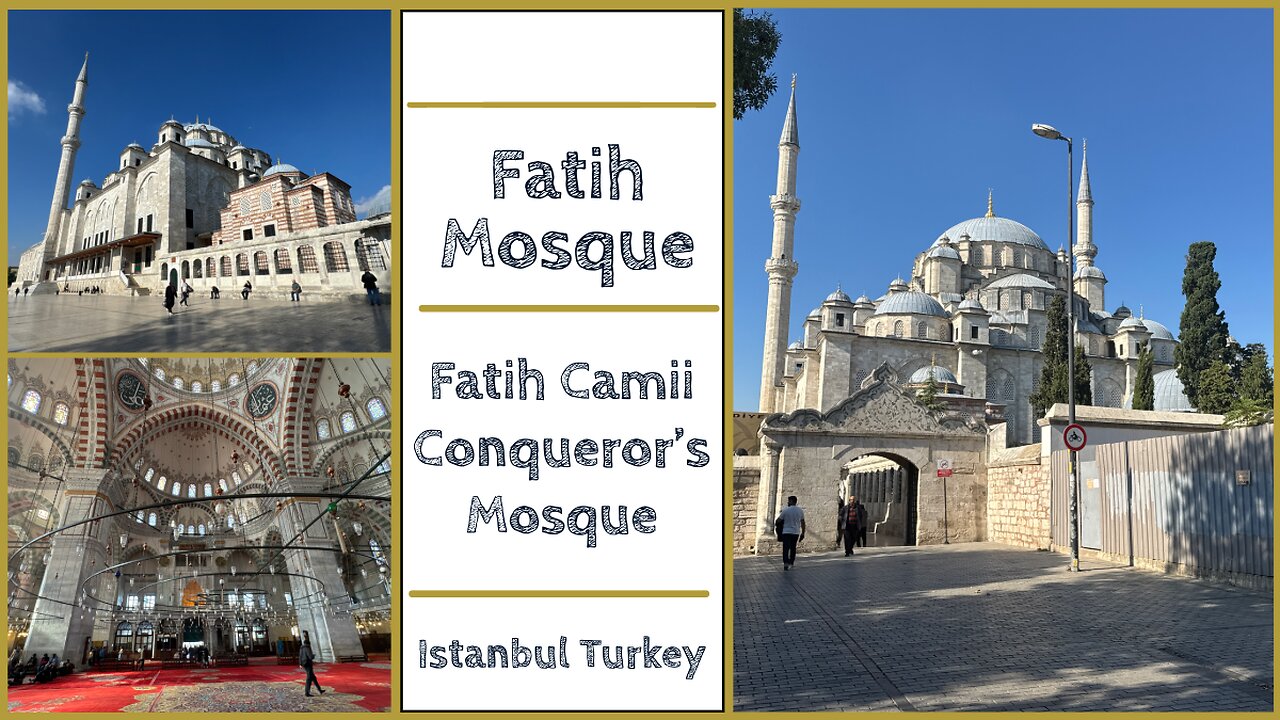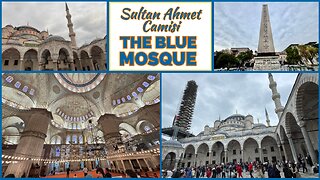Premium Only Content

Fatih Mosque: Istanbul’s Hidden Gem of Conquest and History - Turkey 2025
The mosque built by Sultan Mehmet II (Mehmed the Conqueror) after the fall of Constantinople in 1453 is the Fatih Mosque (Turkish: Fatih Camii, meaning “Conqueror’s Mosque”)
The Fatih Mosque, located in Istanbul’s Fatih district, was commissioned by Sultan Mehmet II to commemorate his conquest of Constantinople. Completed in 1470, it was built on the site of the Byzantine Church of the Holy Apostles, a significant 4th-century Christian complex second only to Hagia Sophia in importance. The mosque symbolized Ottoman dominance and the transformation of Constantinople into Istanbul, the new capital of the Ottoman Empire.
The Church of the Holy Apostles, originally constructed around 330–336 AD under Emperor Constantine the Great and rebuilt by Justinian I in the 6th century, housed relics of apostles and served as an imperial burial site. Its location on Constantinople’s fourth hill was strategically supported by the 4th-century Valens Aqueduct (completed 373 AD), which supplied water to the church’s cisterns and surrounding religious complexes, including those near the later Fethiye Mosque. Mehmet II razed the dilapidated church to build his mosque, repurposing its materials and symbolically claiming the city’s Roman and Byzantine legacy for the Ottoman era.
The Fatih Mosque was part of a larger külliye (complex) including a madrasa, hospital, hospice, and public kitchens, showcasing Mehmet’s vision for Istanbul as an Islamic cultural center. The original mosque was heavily damaged by an earthquake in 1766 and rebuilt in 1771 under Sultan Mustafa III, blending Ottoman baroque elements with the original classical design.
The original Fatih Mosque, designed by architect Atik Sinan, featured a grand central dome (26 meters in diameter) supported by four slender minarets and semi-domes, inspired by Hagia Sophia’s layout but with Ottoman innovations. The rebuilt 18th-century structure retains a large central dome, two minarets, and a spacious courtyard with an ablution fountain. The interior is adorned with Iznik tiles, calligraphy, and marble columns, some salvaged from the Church of the Holy Apostles, linking it to Roman-era craftsmanship.
The complex’s proximity to the Valens Aqueduct (1 km away) underscores how Roman infrastructure continued to support Ottoman urban life. The mosque’s külliye included eight madrasas, a library, and a caravanserai, fostering scholarship and charity.
The Fatih Mosque stands as a monument to Mehmet II’s conquest and Istanbul’s transition from a Roman/Byzantine to an Ottoman city. Its foundation on the Church of the Holy Apostles, reliant on the Valens Aqueduct’s water system, ties it to 4th-century Roman engineering. As part of Istanbul’s UNESCO-listed Historic Areas, it remains a vibrant place of worship and a historical landmark, reflecting the city’s multicultural legacy.
Enjoy the video!
If you would like to support the channel through unique items only found here visit my store
https://youtube.com/channel/UC7Nk0oxkpoyOXvZ-BESD6-g/store
You can also see my videos on Rumble, Bitchute, Odysee and Subscribe Star. If you have any questions or comments and wish to contact me directly I can be reached by email at [email protected]
https://www.bitchute.com/channel/pYUe8EgYcUMc/
https://odysee.com/$/latest/@EndlessJourney
https://rumble.com/c/EndlessJourney
https://www.subscribestar.com/endless-journey
Follow me on Twitter @AEndlessJourney
#endlessjourney
#travel
#turkey
-
 11:36
11:36
Endless Journey
3 days agoThe Blue Mosque: Istanbul’s Dazzling Icon & UNESCO World Heritage Site - Turkey 2025
6 -
 LIVE
LIVE
OhHiMark1776
4 hours ago🟠 10-16-25 ||||| Act 3 Continue ||||| Baldur's Gate 3 (2023)
44 watching -
 5:28:43
5:28:43
The Rabble Wrangler
18 hours agoBattlefield 6 with The Best in the West
1.99K -
 1:02:05
1:02:05
BonginoReport
4 hours agoMusic Stars Go Viral For Anti-ICE Rants - Nightly Scroll w/ Hayley Caronia (Ep.157)
45K33 -
 LIVE
LIVE
NostalgiaMicrodosing
2 hours ago $0.03 earnedLIVE - Digital Déjà Vu
22 watching -
 LIVE
LIVE
GritsGG
7 hours agoRANKED GRIND! Most Wins in WORLD! 3734+!
37 watching -
 1:05:06
1:05:06
TheCrucible
4 hours agoThe Extravaganza! EP: 55 with guest co-host Rob Noerr (10/16/25)
95.7K7 -
 1:24:30
1:24:30
Kim Iversen
4 hours agoSpotify Bans Nick Fuentes — But the Shift Can’t Be Stopped
41.6K65 -
 1:50:47
1:50:47
Robert Gouveia
3 hours ago🚨 John Bolton INDICTED!! Antifa Terrorists ARRESTED!! Shutdown Firings FIGHT!
39.7K6 -
 2:21:57
2:21:57
MattMorseTV
6 hours ago $79.96 earned🔴Trump's EMERGENCY Oval Office ANNOUNCEMENT.🔴
133K96